EM question bank PDF

| Title | EM question bank |
|---|---|
| Author | AVINASH YADAV |
| Course | Engineering Mechanics |
| Institution | Anna University |
| Pages | 10 |
| File Size | 127.6 KB |
| File Type | |
| Total Downloads | 51 |
| Total Views | 119 |
Summary
question bank ...
Description
GE6253: ENGINEERING MECHANICS ( Question Bank ) UNIT -1(BASICS & STATICS OF PARTICLES) 1.
Define force? Force is a physical quantity that changes or tires to change the state of rest
or of uniform motion of an object 2.
Differenciate between particles and rigid body? Particle is a bo dy which has mass but no dimension where as rigid body as
both mass and dimensions.Particle can have only translational motion where as rigid body can have translational as well as rotational motion. 3.
State newton’s first law of motion? Everybody tries to be in it’s state of rest or of uniform motion along a
straight line unless it’s acted upon by an external unbalanced force . 4.
State newton’s second law of motion?
The rate of change of momentum of a body is directly proportional to the applied force and takes place in the direction of the force . 5.
State newton’s third law of motion? Every action has an equal and opposite reaction .
6.
State law of parallelogram of vectors? If two vectors are represented in magnitude and direction by two adjacent
sides of a parallelogram,their resultant is represented in magnitude and direction by the diagonal of the parallelogram drawn from the common point. 7.
State the principle of transmissibility of force with simple sketch?
According to principle of transmissibility of force,the force can be transmitted from one point to another on it is line of action without causing by any change in the motion of the object. EG:force F can be transmitted from A to B. 8.
Define unit vector? A vector having magnitude one unit is known as a unit vector .
9.
Define the following terms? (a)coplanar forces (b)concurrent forces (a)If all forces act in one plane,they are known as coplanar forces. (b)If lines of action of all forces intersected at a single point,the forces are
known as concurrent forces. 10.
Defferentiate between collinear and concurrent forces? Collinear forces act along the same line where as concurrent forces have
lines of action intersecting at one point. 11
.Define resultant of coplanar concurrent force system? A system of coplanar concurrent forces can be reduced to a single force
which is known as resultant force.
12.
what is the difference between a resultant force and equilibrant
force? Resultant force makes the object move whereas equilibrant force keeps it in equilibrium. 13.
state triangle law of forces? If two forces are represented in magnitude and direction by two sides of a
triangle taken in order,their resultant is represented in magnitude and direction by the third side of the triangle drawn from starting point of first force to end point of the second force. 14.
State parallelogram law of forces? If two forces are represented in magnitude and direction by two adjacent
sides of a parallelogram,their resultant is represented in magnitude and direction by the diagonal of the parallelogram drawn from the common point. 15.
Statelami’s theorem?
If three concurrent forces are in equilibrium,magnitude of any force is proportional to the sine of angle between the other two forces. 16.
State the necessary and sufficient condition for static equilibrium of a
particle in two dimensions? For static equilibrium of a particle in two dimensions, i)The algebraic sum of horizontal components of all forces acting the particle must be zero. ii) The algebraic sum of vertical components of all forces acting the particle must be zero. 17 .State triangle law of equilibrium?
If three forces acting on a particle are represented by the three sides of a triangle in magnitude and direction when taken in order,the particle will remain in equilibrium. 18.What is a free body diagram? A force system,in a plane,in which the lines of action all forces intersect at a single point is called coplanar concurrent force system. UNIT- 2(EQUILIBRIUM OF RIGID BODIES 1.State varignon’s theorem? The algebraic sum of moments due to all forces acting on the object about any point is equal to the moment of their resultant about the same point. 2.Define couple? Twonon collinear parallel forces having same magnitude but opposite direction from a couple. 3.Why the couple moment is said to be a free vector? Couple moment is said to be a free vector as it can be transferred to any point in the plane without causing any change in its effect on the body. 4.Distinguish between couple and moment? Moment represents the turning effect of a force where as couple consists of two equal and opposite forces separate by some distance.moment of force various from point to point but moment of a couple is same about any point in the plane.
5.What is meant by force-couple system? A system of coplanar non concurrent force system acting in a rigid body can be replaced by a single resultant force and couple moment at a point known as force couple system. 6.Can a coplanar non concurrent system with zero resultant force necessarily be in equilibrium? A coplanar non concurrent system with zero resultant force is not necessarily In equilibrium as it can have a non zero resultant moment. 7.When is moment of force zero about a point? The moment of force about a point is zero its line of action passes through that point. 8.When is moment of force maximum about a point ? Moment of force is maximum about a point when, i)Its applied at maximu m result from the point and, ii)It is applied perpendicular to the line joining application of force. 9.When is moment of force zero about a line? Moment of force about a line is zero when, i)Force is parallel to that line or, ii)Line of action of force intersects that line.
the point to the point of
10.Explain free body diagram with one example? Free body diagram is the isolated diagram of an object\system of objects\any point in the system in which all forces at couple moment acting on it are shown including support reactions example:consider a ladder of weight W having rollers at it’s end’s as shown in figure. 11.Statethe necessary and sufficient conditions for equilibrium of rigid bodies in two dimensions? The necessary and sufficient conditions for equilibrium of rigid bodies in two dimensions are: 1)algebraic sum of horizontal components of all forces acting on the body is must be zero, 2)Algebraic sum of vertical components all forces acting on the body is must be zero, 3)Algebraic sum of moments due to all forces and couple moments acting the body is in must be zero. 12.Write the equation of equilibrium of a rigid body? The three equations of a rigid body are: ∑Fx=0,; ∑Fy=0,; ∑M=0.
l
13.Write the conditions equilibrium of a system of parallel force acting in a plane ? The two conditions of equilibrium of a system of parallel forces acting in a plane are : 1)Algebraic sum of all forces must be zero, 2)Algebraic sum of moments due to all forces about any point must be zero. 14.What are the reactions at a fixed support of a plane beam that are possible? The reaction at fixed support of a plane beam consist of , 1)A reaction force in the plane which can be represented by it’s two components(Generally taken to be horizontal and vertical)&, 2)Areaction moment. 15.How many scalar equations can be obtained for equilibrium of rigid body in three dimensions? Six scalar equations can be obtained for equilibrium of a rigid body in three dimensions.
l
UNIT- 3(PROPERTIES OF SURFACES AND SOLIDS) 1.
Define centroid of gravity. Centroid is the geometrical center of the body whereas center of gravity is the point through which weight of the body acts.
2. Difine first moment of an area about of an axis. The first moment of an area about of an axis is the product of an area and the perpendicular
distance of its centroid from axis.
3. Define line of symmetry. Line of symmetry is line a about which the area on one side is a mirror image of the area of the side 4. State pappus-guldinus theorem for finding surface area. The area of surface of revolution is equal to the product of the length of the generating curve and the distance travelled by the centroid of the generating curve while generating that surface. 5.What is uniform motion. If the velocity of body does not change with time ,then the motion is called as uniform motion. 6.state parallel axis theorem. Moment of inertia of an area about an axis is equal to the sum of (a) moment of inertia an axis passing through the centroid parallel to the given axis and (b) the product of area and square of the distance between the two parallel axes. 7.Define principal axes and principal moment of inertia.
l
The axes about which moments or inertia is maximum and minimum are known as principal axes .when these two axes are passing through centroid of aera it is known a centroidal principal axis.now the maximum and minimum moments of inertia are called principal moments of inertia. 8.What is called the coefficient of static friction. As the force ‘P’ increases, ‘F’ also increases but the body remains at rest and is in equilibrium. If ‘F’ reaches a limiting value friction or from when ‘P’ is increases it loses its balance and hence the body slides to right. 9.state the Coulomb’s laws of dry friction. (i) when a body kept on another body is subjected to a horizontal force, friction force developed at the surfaces of contact of two bodies has a magnitude equal to that of the horizontal force applied. When one body moves over another,the magnitude of the friction force is less than that of the horizontal force. (ii) The friction force acts in the direction opposite to that of the moving body. (iii) The friction force is proportional to the normal reaction developed at the contact surface. (iv) The friction force does is not depend on the apparent area of the surfaces in contact 10.What is the condition in terms of efficiency for a machine to be selflocking. When the efficiency of a machine is less than 50%, it is said to be selflocking
UNIT- 4 (DYNAMICS OF PARATICLES)
1.State D’Alembert’s principle The force system consisting of external forces and inertia force can be considered to keep the particle in equilibrium.since the resultant force externally acting on the particle is not zero ,the particle is said to be in dynamic equilibriums.the principle is known as D’Alembert’s principle. 2.what is general plane motion. Any plane motion which is neither a rotation nor a translation but considered as the sum of translation and rotation. 3.Define the term co-efficient of restitution. The co-efficient of restitution between two bodies in a collision is defined as the ratio of the relative velocity of their separation after collision to the relative of their approach before collision. 4.Define angle friction. Angle of friction is the angle between resultant reaction of one body on another and normal to the common tangent between two bodies when the motion is impending. 5.what are motion curves. The path described by a particle or a rigid body with respect to time is called motion curve.
10 10...
Similar Free PDFs

EM question bank
- 10 Pages

Dmdw-question bank - question bank
- 17 Pages

Question bank
- 8 Pages
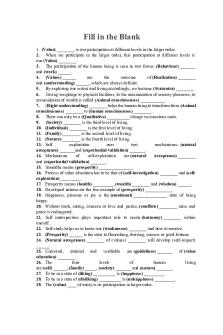
Question Bank 3question bank
- 6 Pages

Question BANK
- 19 Pages
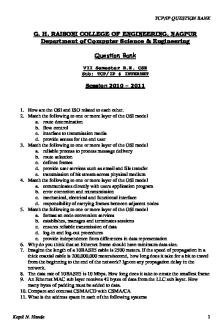
Tcp-ip-question-bank
- 25 Pages

Chapter 4 - Question Bank
- 28 Pages

DIP Question Bank Sheetal
- 14 Pages
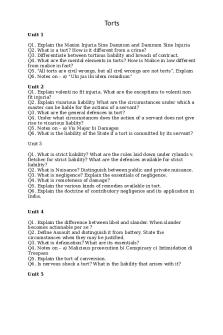
Torts Question Bank
- 2 Pages
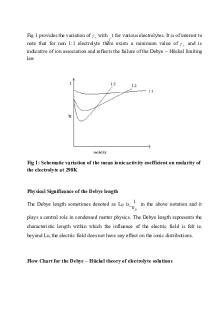
QB5 - Question Bank 5
- 104 Pages

Assessment Question Bank 1
- 22 Pages
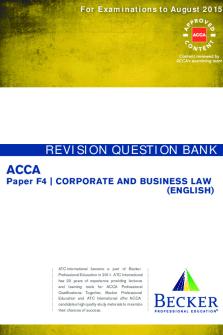
Revision Question Bank 60
- 154 Pages
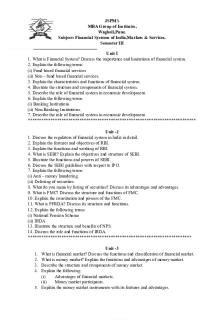
Fsims Question Bank
- 4 Pages

11. Autocad question bank
- 14 Pages
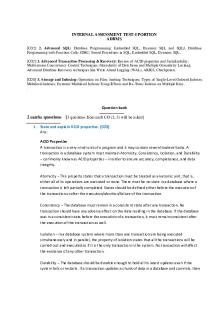
Question bank Adbms - solution
- 45 Pages

Viva Question Bank - CSS
- 17 Pages
Popular Institutions
- Tinajero National High School - Annex
- Politeknik Caltex Riau
- Yokohama City University
- SGT University
- University of Al-Qadisiyah
- Divine Word College of Vigan
- Techniek College Rotterdam
- Universidade de Santiago
- Universiti Teknologi MARA Cawangan Johor Kampus Pasir Gudang
- Poltekkes Kemenkes Yogyakarta
- Baguio City National High School
- Colegio san marcos
- preparatoria uno
- Centro de Bachillerato Tecnológico Industrial y de Servicios No. 107
- Dalian Maritime University
- Quang Trung Secondary School
- Colegio Tecnológico en Informática
- Corporación Regional de Educación Superior
- Grupo CEDVA
- Dar Al Uloom University
- Centro de Estudios Preuniversitarios de la Universidad Nacional de Ingeniería
- 上智大学
- Aakash International School, Nuna Majara
- San Felipe Neri Catholic School
- Kang Chiao International School - New Taipei City
- Misamis Occidental National High School
- Institución Educativa Escuela Normal Juan Ladrilleros
- Kolehiyo ng Pantukan
- Batanes State College
- Instituto Continental
- Sekolah Menengah Kejuruan Kesehatan Kaltara (Tarakan)
- Colegio de La Inmaculada Concepcion - Cebu